The Biography of a Book: Alice at the Morgan
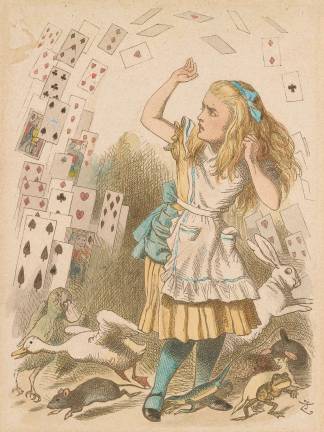
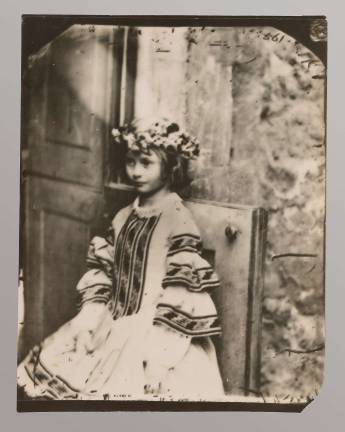
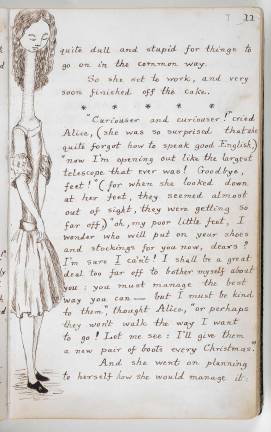
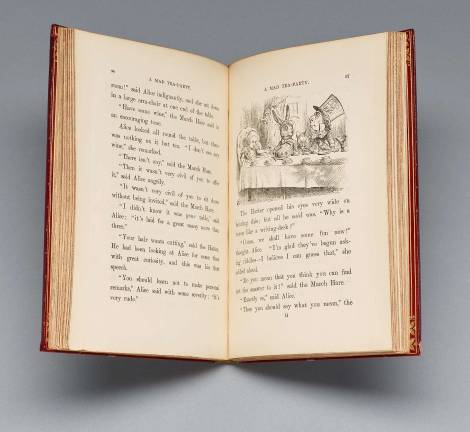
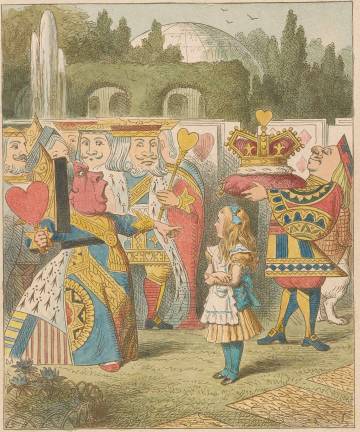
This year marks the 150th anniversary of the publication of Alice’s Adventures in Wonderland, Lewis Carroll’s beloved tale of a 7-year-old girl who famously falls down a rabbit hole and mixes with a mad cast of characters before awakening from her dream. Alice-mania is slowly gaining steam in the city, with upcoming shows at The Grolier Club, The New York Public Library for the Performing Arts and Columbia University, where real-life Alice — Alice Liddell Hargreaves — received an honorary doctorate in 1932, the centenary year of Carroll’s birth.
For its part, The Morgan Library & Museum has pulled off a curatorial coup and secured the original manuscript from the British Library in London, building a wonderland of an exhibit around it, now through October 11. It’s “a biography of the book ... the story of the story,” curator Carolyn Vega said during a crowded tour of the show on a recent Friday night.
Not seen on this side of the pond for more than 30 years, the manuscript is enclosed in a glass case at the center of the gallery and opened to pages 10 and 11, the latter boasting a drawing of a long-necked Alice by Carroll, an amateur artist. The document forms the heart and soul of the exhibit, a reference point to which we keep returning as we survey walls and display cases filled with vintage books, original drawings, hand-colored proofs, letters, photos and Alice Liddell’s leather purse and prayer book. There is even a touchscreen with a digitized manuscript that you can tap for a page-by-page view of Carroll’s neat handwriting and illustrations, the inspiration for some of John Tenniel’s later drawings for the published book.
One of the greatest works of children’s literature can be sourced to a summer outing on “a perfect English afternoon” on July 4, 1862, Vega said about Alice's backstory. Christ Church, Oxford, math lecturer Charles Lutwidge Dodgson (who years earlier had assumed the pen name Lewis Carroll) took the dean’s three daughters — Lorina, Alice and Edith Liddell — on a boat trip up the River Thames to Godstow for an afternoon picnic. To entertain the group, Carroll spun a tale of a little girl who follows a white rabbit in a waistcoat down a hole and enters a curious, netherworld of anthropomorphized creatures and madcap characters spewing “logical nonsense.”
Carroll was extemporizing — literally making it up as he went along. Alice later begged him to write the story down and give it to her. He started writing the next day, spending two and a half years on the text and on 37 pen-and-ink drawings before presenting the completed work to the youngster as a Christmas present in 1864. He called it “Alice’s Adventures Under Ground.”
But he wasn’t satisfied with the title, which he considered “too didactic,” Vega said, so he sought the advice of a friend — weighing the merits of “Alice Among the Elves” against “Alice’s Doings in Elf-Land,” among others — before swapping out “Under Ground” for “In Wonderland,” which was his idea. “I want something sensational,” he wrote in a letter to his friend that is on display.
Meanwhile, Carroll had been sending drafts of the manuscript to friends, who encouraged him to expand the spontaneous tale and publish it. After adding a wealth of new material — including the chapter “A Mad Tea-Party” — he entered into an agreement with Macmillan and Co. to produce the book, which was now twice the length of the original manuscript.
Carroll arranged to finance the work’s publication himself “so he could be very involved,” Vega said. “He was involved at every stage of the design and production of the book. ... He was [especially] interested in how illustrations and text interact.” Longtime Punch cartoonist John Tenniel was commissioned to re-illustrate the story, collaborating closely with Carroll, who had definite opinions about the size and placement of the pictures.
The book was finally published in the summer of 1865, the third anniversary of the story’s first telling. But Tenniel was not satisfied with the way the illustrations looked — only some 20 of the 2,000 copies from this first print run survive, two of which are thrillingly here — because he found the “printing inferior,” Vega said.
Ever the perfectionist, Carroll decided to recall the entire edition and, at great personal expense, start over. The second printing of 2,000 books in November 1865 cost Carroll more than 250 pounds; he now needed to sell two full editions — 4,000 copies—just to break even. But the book was “an immediate success,” Vega said, and, within a year, sold 4,000 copies, allowing the author to recoup his investment. It has been in print ever since.
Carroll’s story is a tale for the ages, much like Shakespeare’s plays. “We’ll still be reading Alice in another 150 years,” Vega concluded with a smile.